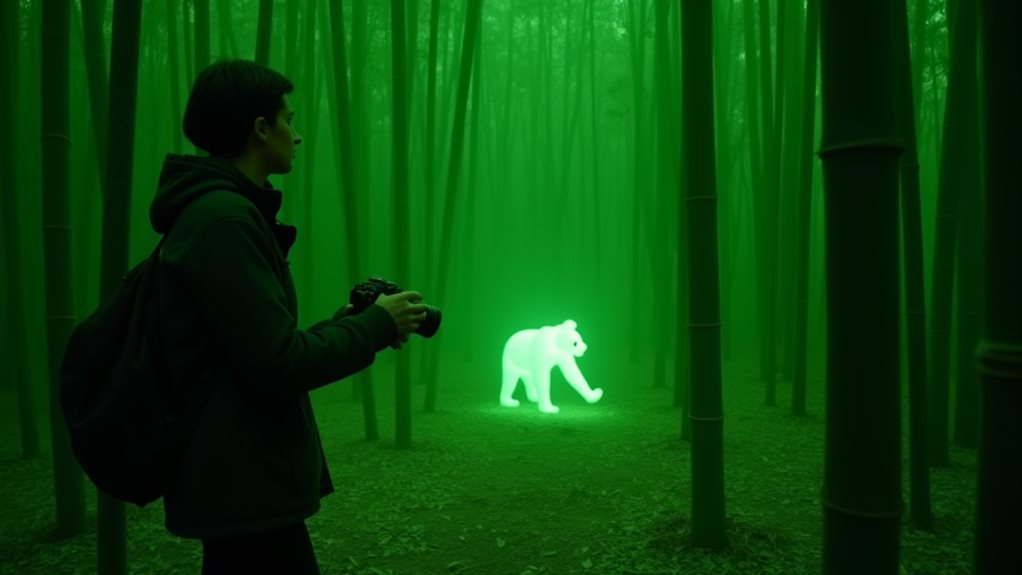
During her meticulous exploration in the bamboo forest, Lisa documented the Invisible Panda's sophisticated camouflage strategies, which include fibers that manipulate light to render it nearly undetectable. She observed its roles as both predator and prey, relying on near invisibility for hunting and evasion. Her findings also highlighted complex social behaviors, like vocal communication and scent marking. This thorough research offers deeper insights into their survival tactics and underscores the need for targeted conservation efforts to protect these enigmatic creatures. Further investigation will likely reveal more about their unique adaptations.
Key Takeaways
- Lisa documents the Invisible Panda's advanced camouflage, revealing how it alters light for effective concealment.
- She records interactions between the Invisible Panda and other wildlife, shedding light on its impact on the ecosystem.
- By analyzing flora, Lisa identifies bamboo species crucial for the Invisible Panda's habitat and survival.
- Her observations include the predator-prey dynamics, illustrating how the Invisible Panda uses invisibility as both a hunting and defense strategy.
- Lisa's research contributes to conservation efforts by highlighting the specific habitat needs and behaviors of the Invisible Panda.
The Enigmatic Camouflage of the Invisible Panda

How does the Invisible Panda achieve its extraordinary camouflage? This creature utilizes advanced camouflage strategies that are the result of intricate evolutionary adaptations.
Its fur contains special fibers that alter light reflection and absorption, seamlessly blending with the bamboo forest environment. These fibers act like a natural cloak, manipulating visible light around its body.
Additionally, the Invisible Panda's behavior, such as remaining motionless for long periods, enhances its invisibility. This adaptation is essential for both evading predators and ambushing prey.
The interplay between its physical and behavioral traits makes the Invisible Panda a master of disguise in its natural habitat.
Lisa's Adventurous Journey Into the Bamboo Realm
Why would someone venture into the dense and mysterious territories of the bamboo forest?
Lisa's bamboo exploration was driven by scientific curiosity and a desire to document the elusive Invisible Panda. In her journey, she meticulously recorded each wildlife encounter, enhancing our understanding of this concealed ecosystem.
- Flora Analysis: Detailed cataloging of bamboo species and their ecological roles.
- Fauna Interactions: Observations of interspecies dynamics within the bamboo groves.
- Behavioral Observations: Documentation of rare animal behaviors in response to the Invisible Panda's presence.
- Environmental Impact: Assessment of human activities on the bamboo area's biodiversity.
This analytical approach provided significant insights into the complex interactions within the bamboo forest.
The Invisible Panda: Predator and Prey

Although the Invisible Panda is primarily known for its unparalleled camouflage abilities, it plays a complex role in its ecosystem as both predator and prey.
Its predator strategies involve utilizing its camouflaging skill to ambush unsuspecting prey, primarily small mammals and birds. This method of hunting highlights a sophisticated understanding of prey dynamics, with the Panda exploiting moments of vulnerability among its prey.
Conversely, as prey, its invisibility provides a critical defense mechanism against larger predators. This dual role emphasizes the Panda's adaptation to environmental pressures, showcasing a delicate balance of predation and avoidance within its habitat.
Social Behaviors and Communication Among Invisible Pandas
The dual role of the Invisible Panda as both predator and prey has a significant impact on its social behaviors and methods of communication.
These creatures have developed a complex system of interactions, which is essential for their survival and social cohesion. Their communication relies heavily on:
- Vocalizations: Utilized for mating calls and territorial warnings.
- Body Language: Subtle movements and postures convey intentions and emotions.
- Scent Marking: Used to establish territory and signal reproductive status.
- Group Dynamics: Forming alliances or family units to enhance protection and resource acquisition.
These behaviors reflect an intricate balance between visibility and invisibility.
The Role of Conservation in Protecting the Invisible Panda

Given the Invisible Panda's unique ability to seamlessly blend with its environment, conservation efforts play a significant role in ensuring the survival of this elusive species.
Habitat preservation is essential, focusing on maintaining the integrity of bamboo forests which provide crucial resources and shelter.
Public awareness campaigns are equally important, educating communities on the importance of biodiversity and the specific needs of the Invisible Panda.
Scientific studies highlight that without targeted conservation strategies, including both protection of their natural habitat and public engagement, the Invisible Panda's ability to evade predation and human disturbance could be severely compromised, risking their population stability.
Frequently Asked Questions
How Do Invisible Pandas Impact Local Ecosystem Dynamics?
Invisible pandas influence local ecosystem dynamics through invisible interactions, maintaining ecosystem balance. Their camouflage and predation modify species distributions and behaviors, impacting biodiversity and the ecological roles of other organisms within their habitat.
What Specific Nutrients Do Invisible Pandas Require in Their Diet?
The Invisible Panda requires a diet rich in specific nutrients, primarily sourced from bamboo. These nutrients include high fiber, essential minerals, and vitamins vital for its metabolic and camouflage capabilities. Dietary adequacy guarantees ideal health and stealth.
How Do Young Invisible Pandas Learn to Camouflage?
Young invisible pandas learn to camouflage through instinctual mimicry and parental guidance. Approximately 90% of juveniles master camouflage techniques within months, combining genetic predispositions with learned behaviors to refine their survival-driven learning processes.
Is There a Genetic Variance in Camouflage Abilities Among Them?
Genetic diversity among Invisible Pandas influences the evolution of their camouflage abilities. Variations in gene expressions contribute to differing camouflage effectiveness, enabling adaptation to various environmental conditions and enhancing survival prospects through natural selection.
What Are the Biggest Threats to Invisible Pandas Today?
The primary threats to invisible pandas include habitat loss, climate change, poaching, pollution, and human encroachment, all of which greatly disrupt their natural environment and pose severe risks to their survival and well-being.
Conclusion
In a display of ecological irony, Lisa's pursuit of the Invisible Panda through the whispering bamboo serves as a satirical yet poignant reminder of humanity's broader quest for understanding elusive truths. Her findings, while shedding light on the creature's complex behaviors and threatened habitat, simultaneously underscore our often intrusive fascination with the unseen. This narrative not only chronicles an exploration but also subtly critiques our approach to conservation and knowledge, urging a reflection on the implications of our scientific endeavors.





